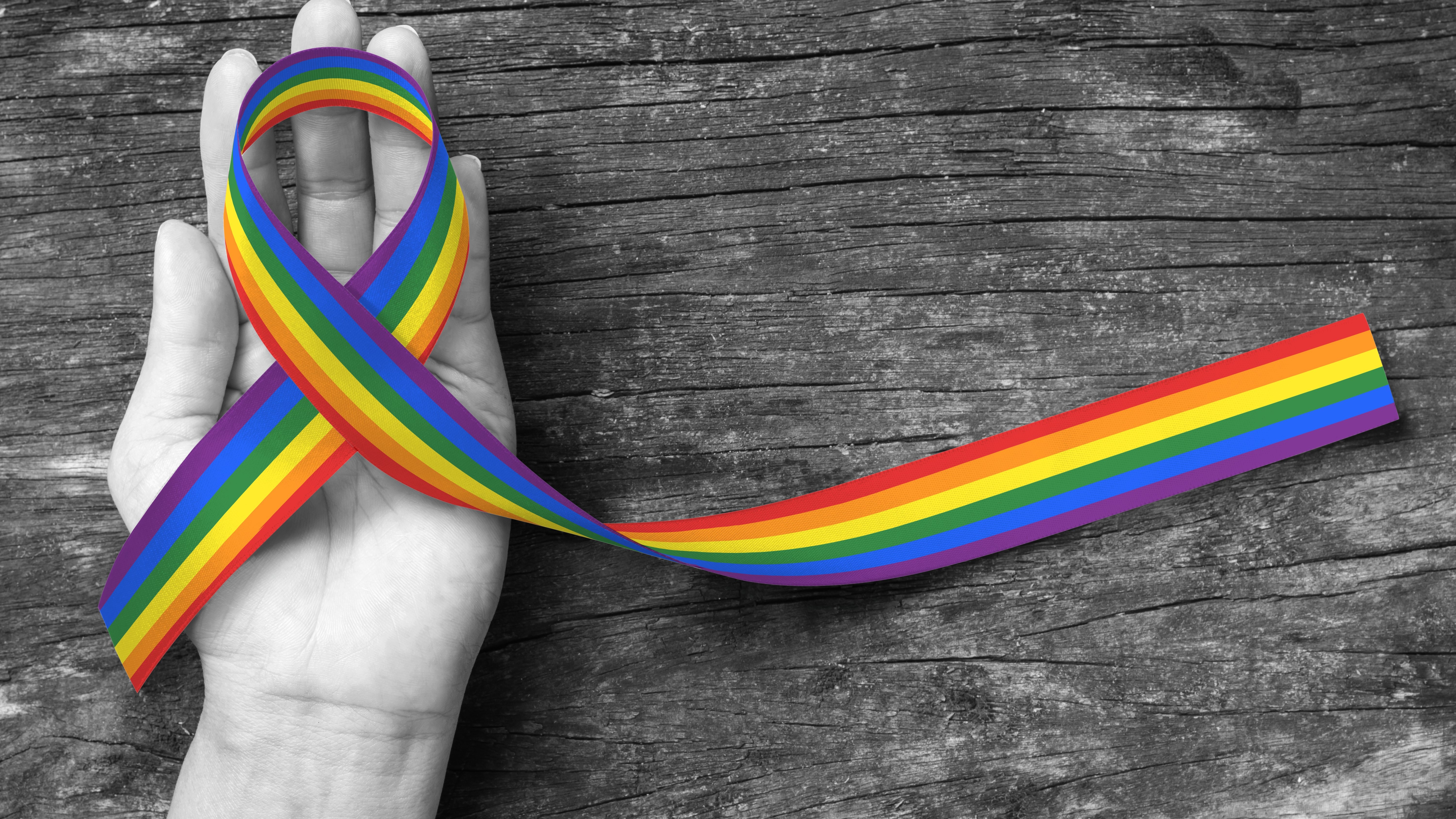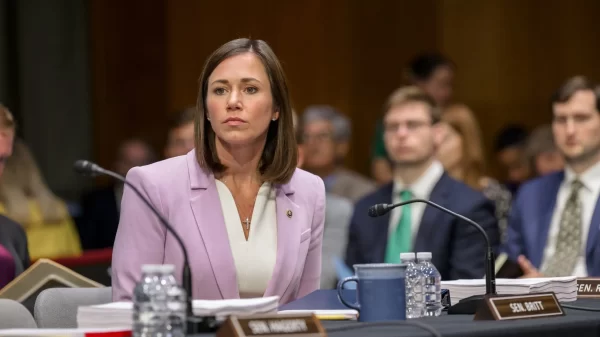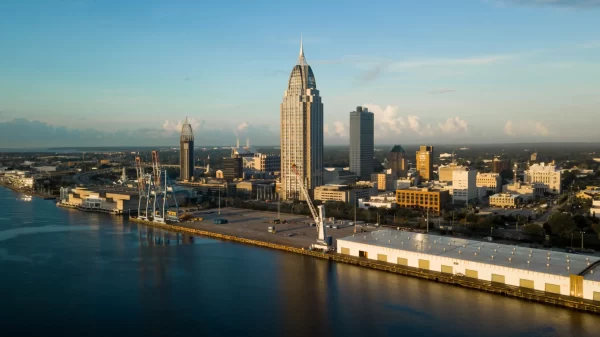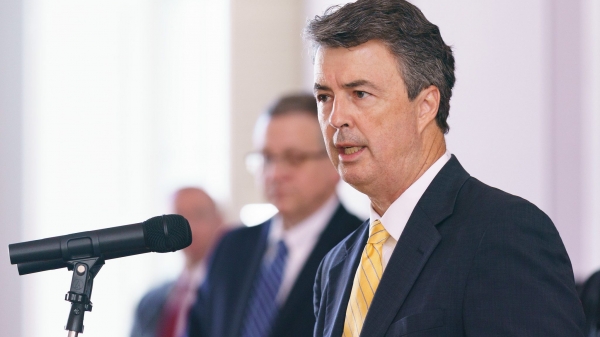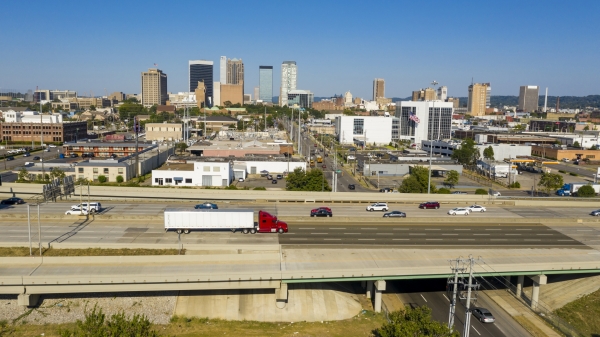Alabama’s governor recently signed a pair of bills—one criminalizing gender-affirming care for transgender youth and another silencing discussion of LGBTQ experience in early elementary education—that reflect wider skirmishes in America’s culture wars. The push by conservative state legislators to further stigmatize LGBTQ people is especially disturbing at a time when advocates say that homelessness and its corrosive effects on mental health disproportionately affect LGBTQ youth.
The fact that young people who are already marginalized may be kicked out of their homes by their parents or guardians angers and motivates Caroline Bundy. Bundy is the Director of Development for AIDS Alabama and the driving force behind the construction of the Way Station, a shelter with wrap-around services geared for the particular needs of homeless youth that will open in Birmingham this fall.
“I think about kids that run away from an abusive or neglectful home life,” Bundy says. “Or they come out as LGBTQ and they’re forced to leave their home by these adults in their lives that they’re supposed to be able to trust. To me, those kids deserve grace. They have not gotten a fair shake.”
That notion of grace—offering help to those who suffer as an expression of God’s unconditional love for humanity—threads through Bundy’s personal history as well as her professional life. In the following Q&A, Bundy talks about the path that led to the creation of the Way Station, her own story, and how her identity as a lifelong Methodist has shaped her activism and informed her belief in the power of grace.
Could you say a bit about the Way Station—the need it responds to—and how it came to be?
Back when AIDS Alabama started, as AIDS Task Force of Alabama, we were awarded a grant from HRSA [Health Resources and Services Administration] to do a needs assessment. What we found out then, back in 1986, was that the primary need for folks who were living with HIV or AIDS was housing. And it is still our focus today, though services have broadened considerably over time. Now we see that unstable housing is a tremendous risk factor for contracting HIV. So we broadened our mission a little bit to include housing for folks who are not living with HIV to mitigate that risk.
So three or four years ago, we were awarded a grant from HUD to rapidly rehouse 19- to 24-year-old young people who were homeless. And the whole concept behind rapid rehousing is that you get folks off the streets and into stable housing first, and wrap supportive services around them second. Whether it’s just a lack of income or it’s substance abuse–whatever it is that they need. That program, called the Ascension Project, has gone gangbusters and grown. And it’s a scattered site program, which means that we have to cultivate relationships with landlords that will take AIDS Alabama’s money to house this individual, and be willing to take a risk on this person even though they know that the rent is paid for.
At the very beginning, we did not have enough relationships with landlords. So our social workers were actually finding these young people and having to do the intake process, but then having to take them back where they found them because we had no place to put them. Social workers were crying, burning out. It was absolutely horrible. That sparked my thinking: We’ve got to have some place, some stopover place. And I actually named the Way Station in a conversation with someone. I said, “We just need a little way station for them to hang out.” And this friend of mine said, “I think you just named your place.”
I feel like it’s going to address a tremendous gap in services because there’s no other place like it in Birmingham. There is no shelter in Birmingham that addresses the very unique needs of homeless youth. They don’t see adult shelters as being a safe place. They worry about their physical health. They worry about abuse, theft of what little property they own. And so they need something that’s geared just for them.
What’s the broader homelessness situation in Birmingham? How large is the segment of the homeless population that you’re looking to address?
Organizations that provide services to homeless populations througha Continuum of Care (CoC) agency do an annual 24-hour, Point-in-Time count of homeless people living in the region they serve. In our case, this means that social workers in the entire Birmingham metro area [six counties with a combined population of 1.1 million] literally fan out in the day, in the night, and try to reach every homeless person that they can. The most complete numbers that we have are from 2020 [the 2021 count was limited in scope because of the pandemic], when more than 3,000 people in the Birmingham metro area were suffering from chronic homelessness.
In the age group of 18 to 24, which is called “unaccompanied youth,” we had 175 young people who were homeless. Of those, 72reported sleeping unsheltered–park bench, tent, a structure with no functioning utilities, car. To me, that’s just not acceptable. It’s not. And that doesn’t even count the ones that are couch surfing, and it doesn’t count the ones that don’t want to be counted, doesn’t count the ones that overstate their age. A lot of them don’t want to be sent back to the situation from which they ran, and so they avoid things like that. They hide. So I think those numbers are probably a little higher. So that’s what we’re up against. The 40 beds in the Way Station could be filled pretty quickly.
Initially I really wanted to serve some younger minors too, but Child Protective Services has some very strict rules about separation of ages. So in order to get this going, I had to shift my age range a little bit older. We were fortunate enough to be able to purchase half a city block for the Way Station. If I live long enough, I would love to be able to establish a smaller house just for minors. It would be probably for ages 14, 15, 16, 17. That age range is hard to place in foster homes, unless the foster parents are very skilled at addressing trauma. They run away a lot. They just need special care.
How did you end up in this line of work? What’s the backstory to your role with AIDS Alabama and the Way Station?
Around 2008, I started working for the YMCA, and I became a personal trainer because at that point I was really into exercise, and I could see the difference that good exercise and good eating could make in your life. And I actually started a group for children who were overweight. I’ve got this soft spot for kids. I don’t know what it is. But we had so much fun because I would teach them how to exercise for their grade level, for their bone structure, and how to make healthier choices. And that was a wonderful opportunity for me.
First I was working at the branch in Mountain Brook [an inner-ring suburb separated from the city of Birmingham by Red Mountain], then I ended up working Downtown, which was a whole other population. You come to the branch in Mountain Brook [one of the wealthiest cities in the US, with a median annual household income of $130,000], and everybody’s got their designer workout clothes on. And the Downtown branch [median annual household income in Birmingham is $39,000] is a whole different animal. I became the membership director, and my office was a fishbowl– a completely glass office in the middle of the foyer. So I would see a lot of homeless folks who would come in and get a cup of coffee, and just hang out and get warm when the weather was cold. We had a very strong financial assistance program there. We could offer a membership for up to 50 percent off of the normal cost to folks who could prove their need and income status. And so that was when I really started saying, “Hey, there’s a whole world out here that needs help.”
And then the Y was awarded–along with Jefferson County Department of Health, the United Way, and anti-tobacco agencies–a tremendous grant from the CDC. Thirteen million dollars for tobacco cessation and obesity prevention. So that threw me into learning more about different partner agencies in Birmingham, especially the United Way and the health department, and I made a lot of really good friends. I learned how grants work, and I learned about ways that programs like [the CDC initiative] can really help people.
In 2014, I started thinking I really might like to try something different. So as things happen, I was at a party at a friend’s house and the CEO of AIDS Alabama was there at the party. And we were introduced, and started talking, and she was very low-key. When I asked her what she did, she said “I work at AIDS Alabama.” She didn’t tell me that she was the CEO.
HIV was not on my radar at all. I’m a gay woman, and I just didn’t think about it. The double-edged sword is that the medications are so good now that nobody’s dying like they used to, but because nobody’s dying like they used to, people don’t realize that the epidemic has shifted into poorer parts of the country, especially in the South. So, I joined AIDS Alabama first as a board member. I was there for about six months when the Director of Development position came open. I started that job on World AIDS Day [December 1] in 2014.
You mentioned being gay. What’s your coming-out story? Where did you grow up, and how did you end up in Birmingham?
I grew up in Montgomery, Alabama, and spent all my life there until I went to college. My father was retired Army, West Point graduate, very disciplined. I was the last child, and very much a trailer. There’s eight and a half years between me and my closest sibling. So I had two older sisters, and an older brother, and then me. I was raised Methodist, and am still Methodist today. I grew up in one of the prettiest churches in Montgomery, First United Methodist Church in Cloverdale Park.
I went to college at the University of Alabama in Tuscaloosa. And really, honestly, never looked back after that. I graduated from Alabama in 1983, and a whole flock of us from the university moved to Birmingham. And a lot of those folks still live here, which is a lot of fun, but Birmingham was just much more intriguing to me than Montgomery.
My coming out story was very under the radar. I was a late bloomer, I’ll put it that way. I was married to a wonderful man. He’s still a wonderful man, and we have a great relationship, and we had two sons together, but they were very young, seven and four, when we divorced. And at that point in time–that was in 2004, I think–it was very hush-hush. My siblings knew about me, but my parents never knew because the divorce was hard enough on them. My father diedthree years ago, and my mother just passed away in October. And my now-wife, they just knew her as my very best friend. It took a little bit of time and tough conversations to reestablish our strong sibling bond, but all four of us are in a very good place now.
You’ve described yourself as a life-long Methodist. Did you ever have a crisis of faith, or conflict around coming out? Did you have to shop around for a church where you could find support?
Never left. I was always at Canterbury [United Methodist Church in Mountain Brook]. And my ex-husband and I both attend the same church. And we’ve gotten to the point now where we can sit togetherat church, and do things like that together. But I was very under the radar at Canterbury for the first few years after our divorce. We had a minister there who I asked for a meeting, and he was progressive and made me feel very good. And then when Valerie and I got married, a wonderful, retired-but-still-teaching minister at Canterbury named Oliver and his wife, Elaine, took us to lunch to celebrate our marriage, and gave us a little wedding present and their blessing. This gave Valerie and me the courage to be more involved in the church, all the while just living our lives, never as flag-wavers. Our current staff is very progressive, but the Methodist Church worries me, as a whole, about where it’s going to go with its LGBTQ views.
Canterbury’s membership is very middle-of-the-road right now. Reconciling Ministries Network is an offspring from the Methodist Church that is extremely… well, their Methodist flames [emblem of the United Methodist Church] are rainbow-colored, which is awesome. A long time ago, before it was cool, Woodlawn United Methodist Church [in Birmingham] was in the Reconciling Ministries Network. And then Avondale came on board, and then when all this stuff started coming up about a schism in the denomination over LGBTQ issues, Highland United Methodist and First United Methodist–they call themselves First Church now—they signed on to be Reconciling Ministries churches.
So you have those very progressive churches where if Canterbury were not to go the way of the progressive side, which is to remain United Methodist–if they voted not to do that as a congregation–then I would be at home going to any of those other churches. I want to stay a Methodist because I understand the doctrine and it suits me, maybe because that’s all I know.
Now, within the Reconciling Ministries, you can be a member as an entire church, you can be a member as a Sunday school, you can be a small organization, or an individual. Our Sunday school class at Canterbury, Pathways, is the anchor that holds me to Canterbury. When we voted to become a Reconciling Ministries Sunday school,we lost some members of our class. Some people dropped out and went to other Sunday school classes. And it’s too bad because we hoped that everybody would support us, but some didn’t.
The idea of social justice and fairness in the Methodist Church is huge to me. That, coupled with the wonderful theory of grace, is what keeps me there. So much of our outreach program is organized around Matthew 25: “As you do to the least of these, you do to me.” And I think that’s a lot of what drives me as far as the Way Station goes, too.
Tell me a bit about is the particular constellation of funders and collaborators that you’ve pulled together to support the Way Station.
I’ve written grant proposals to all the corporate and familyfoundations that were easy to scratch up in Birmingham. Most have been very responsive. The Community Foundation was our very first funder. Second was the Junior League of Birmingham, if you can imagine. They have a very strong focus on anti-human trafficking, so that fit in very nicely. We have governmental funding. And the faith-based community is definitely part of it. It has also been very grassroots. Last year I started this Brick Campaign: You can purchase an engraved brick for $100, and that has met with great success. I’ve gotten donations for $5, $10, $25. I get, sometimes, cash in the mail. I don’t even know who sent it to me. Seriously. Folded greenbacks.
And I will say, not to toot my own horn, but everybody that’s given money to the Way Station has gotten a handwritten thank-you note from me. And I just ordered my third batch of stationary. It’s important to me that people are acknowledged and that they feel part of this.
I think that I was lucky enough to be put in the right place at the right time. The Way Station, I think, is a model that could be emulated in any city. And honestly, if one thing were to come out of this that I would love, is to be able to help other cities do the same thing. Collaboration is key. Nothing happens in a vacuum. And we’ve got some great collaborators here in Birmingham, I think, that are very excited about seeing this come to fruition.
You’ve touched on the social justice tradition in the Methodist culture that has nurtured you, as well as the idea of grace as a motivator for service. How do those two things play out in what you’re doing with the Way Station? What’s the connection?
I was on a panel end of last year, and there were three other directors of nonprofits that were on it with me. And when it was my turn to talk, I asked everybody, I said, “What is your opinion on why a young person becomes homeless?” The first lady that stood up, she said, “They run away from home because they don’t want to listen to their parents and they don’t want to follow their rules.”
It just struck me that there were still people that thought that that’s what it was. They think about juvie detention and all that kind of stuff, but when you think about the myriad of causes of why a young person becomes homeless, and I think about kids in the foster system that age out, and then their foster parents say “I’ve done my job,” or their adoptive parents say, “I’ve done my job. You’re on your own.” And they’re not near ready. And when they’re out on their own, they could do some bad things just to survive. I worked with a probation officer for family court, and she says when young people come in, arrested on charges like shoplifting or even stealing a car, there’s so many reasons behind why they did that.
They have not gotten the upbringing that they need. And I think about the role that poverty plays in that. And I just think that these children deserve grace, and I’m not going in with rose-colored glasses on. I’m not thinking that these kids are going to be walking in saying, “Oh, thank you for giving me something to eat, some food, and for the clothing closet.” There’s going to be some kids with some severe baggage and some anger issues. Who wouldn’t? And trauma. And we do have social workers that are trauma-informed care certified social workers. They’ve got to be able to address the trauma without re-traumatizing this young person.
So I think that’s how it all comes together. And I will say I have two boys–one of them just aged out of the age group that we’ll be serving–but the thought of either one of them being out on the streets, unequipped to live independently, without resources, and just thrust out on their own? It’s horrible to think about. That is not right. But I think there’s enough grace to go around. Lord knows I’ve gotten more than my fair share!




































